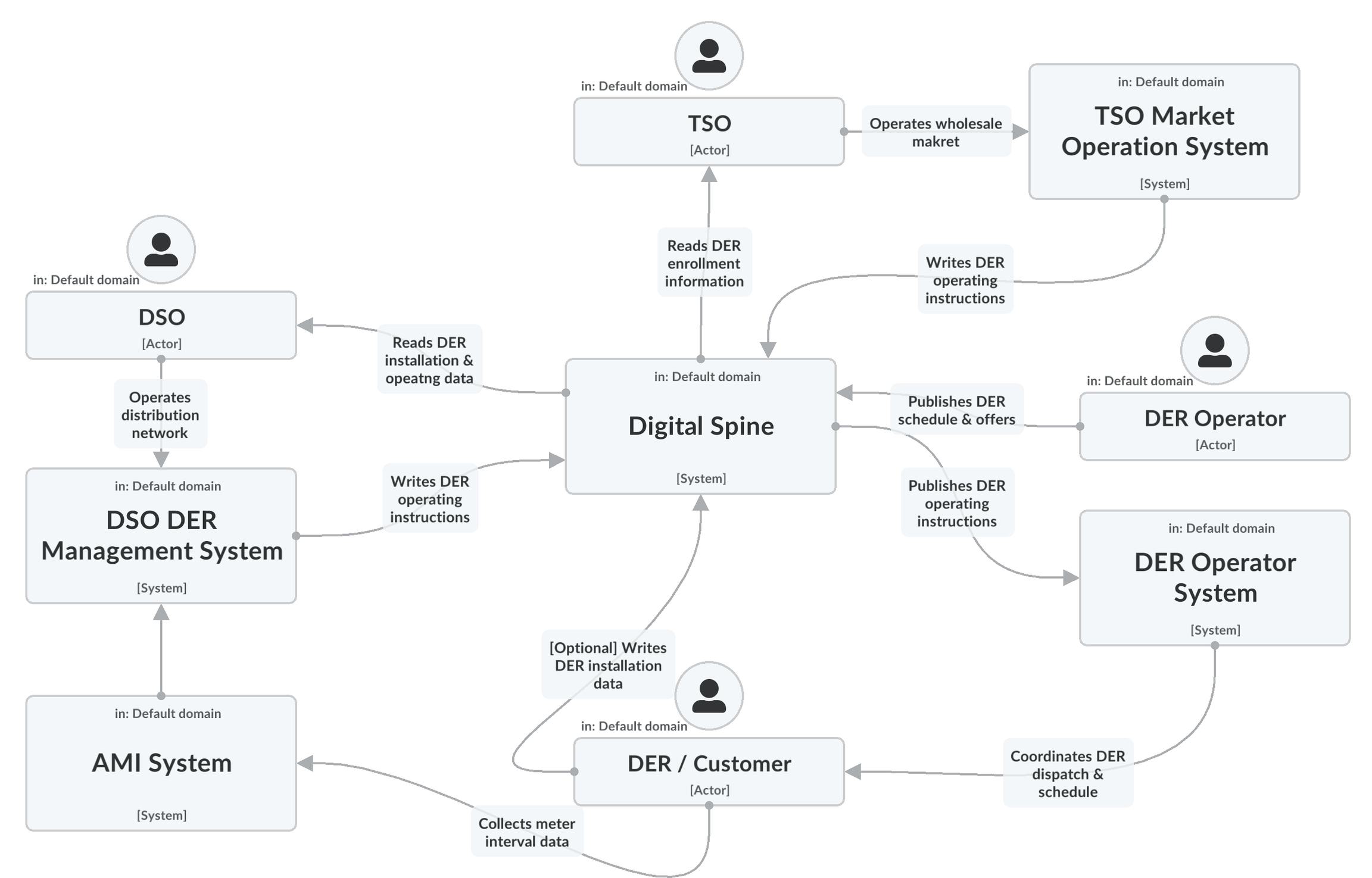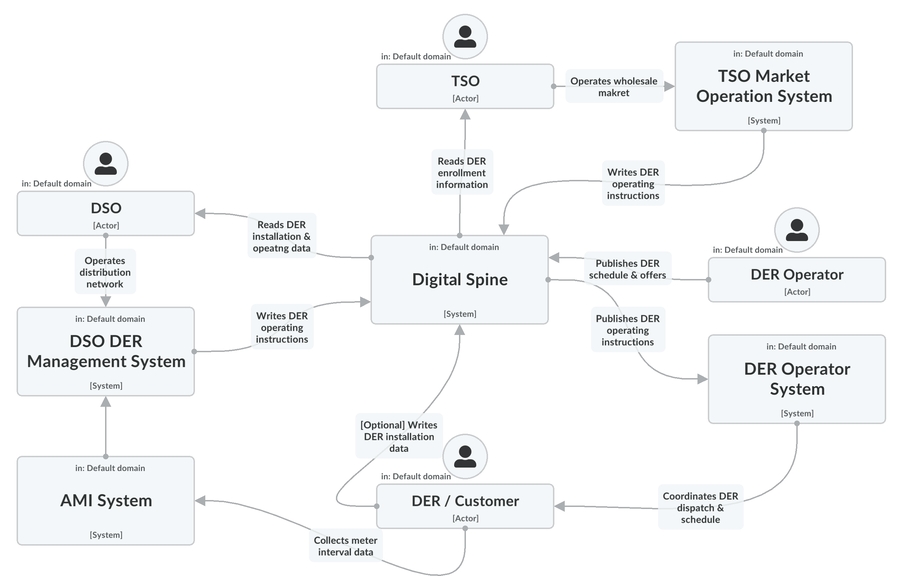Digital Spine for Electricity Markets
Decarbonizing electric grids around the world is the single most impactful step we can take to mitigate climate change. Luckily, we are headed in the right direction: renewables and small scale clean energy assets called distributed energy resources or DERs—assets like electric vehicles, rooftop solar systems, batteries, and other flexible electric loads—are being deployed at an unprecedented rate. Unfortunately, it’s not fast enough: to achieve net-zero emissions by 2050, annual clean energy deployment needs to be three times higher than it is today through at least 2030. And if we want to get there, we have to overcome a serious obstacle: today’s electric utilities are not equipped with the tools needed to manage a renewable grid populated with millions upon millions of DERs.
The grid works by maintaining a precise balance between supply and demand. Today, utilities achieve this via a century-old model: generate power in large, centralized stations and feed it one-way to customers. This model assumes 1) utilities have direct visibility and control over generation (supply) and 2) customer demand for electricity is both passive and predictable. These axioms are no longer valid: renewable energy output is variable and largely a function of weather while demand for electricity from customers—who now own DERs capable of storing electricity, shifting when it’s used, or even injecting power back into the grid— is anything but predictable. A grid composed of vast amounts of renewables and DERs presents a complete paradigm shift for electric utilities.
Utilities have never faced a challenge like this before, nor are they equipped with the tools needed to manage this new paradigm. We aim to change this with a Digital Spine.
Digital Spine Overview
In its simplest form, a Digital Spine is a thin layer of interoperability that connects and communicates information between all of the hardware, software, and organizational systems comprising a grid in near real time. In contrast to the existing information technology landscape that utilities rely on today (which features limited information sharing between isolated and fragmented systems) a Digital Spine offers an open-access, cohesive infrastructure that is jointly governed and operated as a public good.
Today the concept of a Digital Spine - a common digital layer for transactions and interoperability for all actors and processes in an energy system - is being developed in multiple energy markets globally, most notably the UK.
Energy Web's Digital Spine toolkit includes four elements:
Identity and Access Management (IAM): this component implements a unified authentication and authorization framework using self-managed, sovereign digital identities. This gives utilities and other grid participants the ability to mutually authenticate each other’s identity and authorize selective disclosure or communication of information based on their respective roles and responsibilities. A key benefit of this approach, in contrast to existing piecemeal systems, is delivering a “single sign on” user experience that improves interoperability and streamlines trusted integrations between devices, systems, and organizations without relying on a central administrator.
Data and Message Exchange Module: this component is a secure, open-access messaging infrastructure that 1) allows market participants to send, receive, and authenticate messages based on the roles that have been issued to and associated with their self-managed identity; 2) allows market participants to exchange diverse datasets, ranging from real-time telemetry to bulk file uploads; and 3) requires only a single integration mechanism with a central infrastructure in order to communicate via one:one (unicast), one:many (broadcast), and many:many (multicast) channels.
Data Hub Client Gateway: this component is an independent application that Digital Spine participants deploy in order to access the shared message broker. The Client Gateway provides a standardized interface to read and write messages in specific channels within the message broker.
Joint Business Processing: for DERs to be fully utilized, in many instances information needs to be transmitted amongst three or more parties in a way that does not reveal all data to all parties. In these instances, Energy Web has developed an open source, decentralized technology called “Worker Nodes” that ingest data from external sources, execute custom workflows based on predefined business logic, and vote on results in order to establish consensus without revealing or modifying the underlying data. This technology borrows concepts from public distributed ledger solutions, namely distributed consensus protocols which use cryptographic techniques to establish provably correct and timely results.
Digital Spine Use Cases
Collectively, these four components provide a shared digital infrastructure that facilitates communication and coordination between utility hardware and software systems–from smart meters to network planning tools–and DERs and the companies who manage them. Ultimately, a Digital Spine exists to enable new applications provided by other software vendors and utilities themselves, including:
Demand Response / Transactive Energy / Virtual Power Plants: Though there are many different names for it, the concept of using market mechanisms and dynamic pricing to influence DER behavior is well established globally. The Digital Spine enables distribution utilities to construct sophisticated transactive energy programs that procure grid services from DERs at specific locations and/or at specific times of day. For this use case, the role of the Spine is to facilitate data exchange and validation between the utility’s operations center and multiple third-party DER operators.
Network Optimization via Operating Envelopes: Operating envelopes (also called Dynamic Line Ratings) are an emerging solution for dynamically modifying import (consumption) or export (generation) of DERs to the distribution network. The core function of an operating envelope is to define limits on how much power can be injected or drawn by DER based on physical constraints within the distribution system. For this use case, the role of a Digital Spine is to ingest and partition (i.e. route) operating envelopes to the appropriate DER operators so DER can safely sell services wholesale and to the distribution utility.
Moving forward, our full vision for a Digital Spine includes additional applications where consortium building and technology integrations with existing vendors is critical:
Distribution network modeling / analytics solutions: Utilities need partners that can ingest both traditional system data and DER data to construct digital twins of entire networks in different ways and provide advanced analytical capabilities to utilities to support both operations and planning.
Optimization solutions: Dynamic line ratings (also called operating envelopes) are one way of optimizing dispatch of DER at the distribution level. There are many other companies that offer solutions to help optimize dispatch and management of DER who can use a Digital Spine to efficiently communicate distribution network conditions and constraints to other market participants.
Forecasting solutions: Today many companies offer forecasting capabilities (e.g. system demand, power flows within specific network lines, renewable output, etc.). A Spine can enhance forecasting capabilities by making additional datasets that are currently too complex or costly to integrate available to forecasting providers.
Real time operations solutions: Today there are many companies offering DER management systems and advanced distribution network management systems, but they are not ubiquitous. A Spine could make it easier to bring these solutions to utilities who currently lack them.
Last updated

